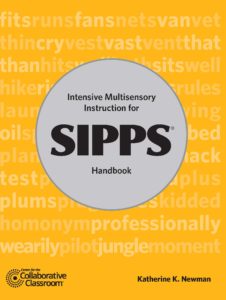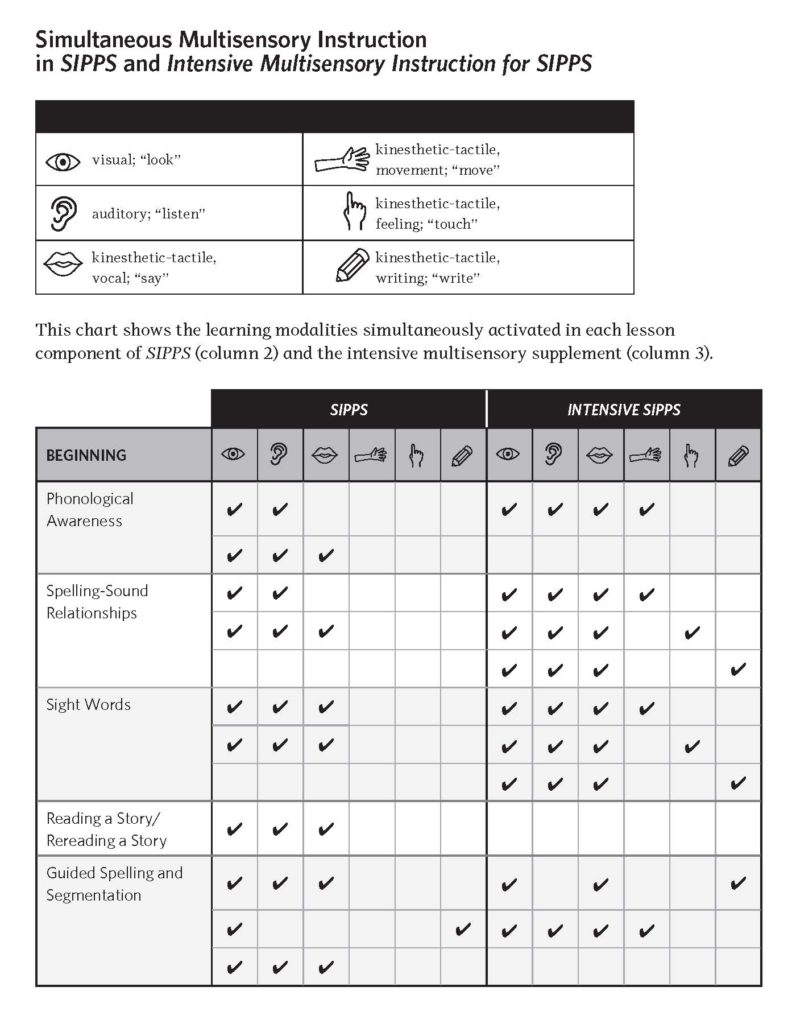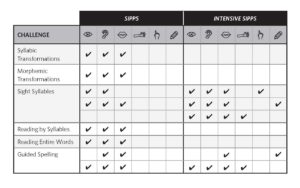- Are you striving to support students identified with dyslexia?
- Are you striving to support students with other significant challenges in learning to read?
- Are you currently teaching the SIPPS program and noticing that your students require more intensive instruction to strengthen connections among the students’ visual, auditory, and kinesthetic-tactile learning modes?
If you said yes to one or more of these questions, you will want to learn more about the new Intensive Multisensory Instruction for SIPPS component.
What is Intensive Multisensory Instruction for SIPPS?
Intensive Multisensory Instruction for SIPPS is a new component of the SIPPS program that includes expanded routines for phonological awareness, phonics and sight words, and guided spelling. A teacher handbook and consumable student materials are included. The handbook suggests enhancements to the standard SIPPS routines that can be used with students with dyslexia or other significant challenges in learning to read. In the handbook, teachers will find ideas to strengthen the connections among the students’ visual, auditory, and kinesthetic-tactile learning modes.
What type of instruction is offered in the handbook?
 The suggestions in the handbook are to be incorporated into the regular SIPPS lessons for particular small groups. Suggestions are provided for all four SIPPS levels. For example:
The suggestions in the handbook are to be incorporated into the regular SIPPS lessons for particular small groups. Suggestions are provided for all four SIPPS levels. For example:
- New instruction for phonological awareness activities includes student arm and hand motions.
- Expanded routines for new spellings and sight words involve tracing and writing.
- In guided spelling, the students whisper as they write, and they point to each letter as they spell back what they have written.
What instructional supports does the current version of SIPPS provide for students identified with dyslexia or other learning needs?
Check out the Effectiveness of SIPPS for Students with Dyslexia document that explains how the program addresses specific criteria for effective literacy instruction for students with dyslexia. Review the charts below that shows the learning modalities simultaneously activated in each lesson component of SIPPS (column 2) and the intensive multisensory supplement (column 3).
What might I consider before including the suggestions outlined in the Intensive Multisensory Instruction for SIPPS handbook?
It is important to keep in mind that when implemented effectively, SIPPS in its current form has been successful for a wide variety of students including those identified with dyslexia. Before adding enhancements, consider your current SIPPS instruction:
- Is your current SIPPS instruction being taught effectively?
- Do you know and consistently use the routines?
- Do you know and use the correction routines for all students when needed?
- Do you avoid modifying the routines?
- Do you include fluency practice in each lesson?
- Are you making data-driven instructional decisions?
- Do you give the Mastery Tests and analyze the data to drive instruction?
- Do you observe the students during fluency practice and use the data to drive instruction?
- Do you adjust the pace of instruction as needed?
- Do you reteach as needed?
If you need support to refine your instruction, check out the Assessment and Decision Making learning opportunities offered in the SIPPS Teacher Learning System located in the Professional Learning Tab on the Learning Portal. Once you verify that current SIPPS instruction is taught well, consider how you might use the suggestions offered in the handbook:
- What handbook suggestion(s) might benefit my students most?
- Does the suggestion enhance the learning of this particular group of students? If not, what else might I try?
- How long might I continue to incorporate the given suggestion?
- What is the impact of the enhancement on the pacing of the instruction and the length of lessons?
Beginning Level:

Extension and SIPPS Plus Levels:

Challenge Level:

Each level of the SIPPS program now includes this component, but it can also be purchased separately for teachers already using the program. Learn more about this new component here, or contact your local Collaborative Classroom Education Consultant to learn more.
